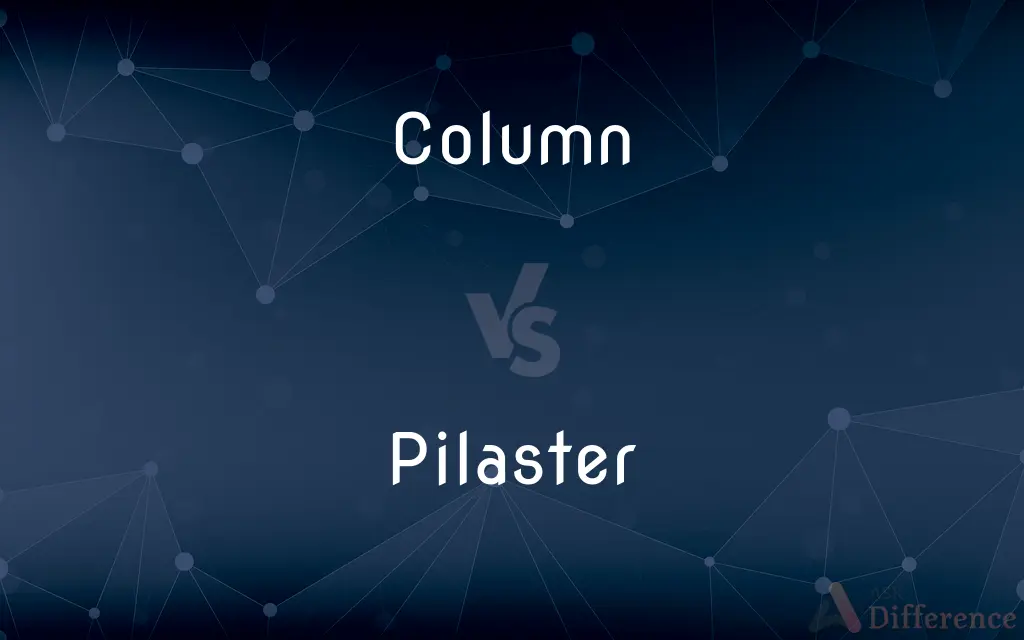Column vs. Pilaster — What's the Difference?
Edited by Tayyaba Rehman — By Urooj Arif — Updated on April 1, 2024
A column is structural element that transmits the weight of the structure above to other structural elements below. Pilaster is flattened column or rectangular support that projects slightly from the wall, serving decorative & structural purpose.

Difference Between Column and Pilaster
Table of Contents
ADVERTISEMENT
Key Differences
Columns are fundamental architectural elements used since ancient times, characterized by their cylindrical shape. They are freestanding and can be load-bearing, supporting the weight of the structures above, such as roofs, arches, or other floors. Columns are designed according to classical orders (Doric, Ionic, Corinthian, etc.) which dictate their proportions, detailing, and decorative elements. Whereas pilasters are more of an aesthetic feature that mimics the appearance of a column but is attached to a wall. They can provide structural support to an arch or beam but do not bear loads in the same way as freestanding columns.
In architectural design, columns are used both for their structural capabilities and their aesthetic appeal, often defining the space they occupy and creating visual rhythms. Pilasters, on the other hand, are used to articulate the wall surface, providing a sense of depth and complexity to flat walls. They are often employed to continue the visual vocabulary of freestanding columns across a facade without requiring the space that actual columns would need.
Columns are typically round in cross-section and can be made from a variety of materials, including stone, brick, wood, or metal, depending on the architectural style and structural requirements. Pilasters, resembling a column flattened into the wall, have a base, shaft, and capital similar to columns but are part of the wall structure. This integration allows them to strengthen the wall by acting against lateral forces, though their primary function in modern architecture is decorative.
The placement of columns is crucial for structural integrity, distributing loads evenly to the foundation. Pilasters, while they can provide some structural benefit, are more flexible in placement, primarily enhancing the wall's aesthetic appeal without significantly altering its load-bearing capacity.
While columns and pilasters may share some visual similarities, their roles in architecture are distinct. Columns are primarily structural, with a significant role in supporting weight and defining spaces, while pilasters are primarily decorative, adding architectural interest and continuity to wall surfaces.
ADVERTISEMENT
Comparison Chart
Primary Function
Structural support to transfer loads.
Decorative; can provide some structural support.
Shape
Cylindrical and freestanding.
Flattened and attached to the wall.
Structural Role
Load-bearing, supporting roofs, arches, or floors.
Offers minor support, mainly decorative.
Placement
Can be interior or exterior, central or peripheral.
Integrated into wall surfaces, interior or exterior.
Material
Stone, brick, wood, metal, concrete.
Same as columns, but is part of the wall construction.
Design Consideration
Designed according to classical orders; defines spaces.
Mimics column design; adds depth and interest to walls.
Compare with Definitions
Column
Defines architectural spaces.
A series of columns creates a rhythmic pathway in the garden.
Pilaster
Often follows classical column designs.
Ionic pilasters decorate the theater's interior walls.
Column
Structural cylindrical support.
The ancient Greek temple features Doric columns.
Pilaster
Provides subtle structural support.
Pilasters stiffen the wall against lateral forces in the ancient villa.
Column
Load-bearing pillar.
Interior columns support the central dome of the building.
Pilaster
Part of the wall's architecture.
The mansion features pilasters that enhance its classical look.
Column
Freestanding architectural element.
Columns at the entrance of the courthouse symbolize justice.
Pilaster
Decorative wall projection mimicking a column.
Pilasters add depth to the flat facade of the Renaissance building.
Column
Designed based on classical orders.
The library's Corinthian columns add an elegant touch.
Pilaster
Structural accent integrated into walls.
Pilasters support the grand archway in the hallway.
Column
A column or pillar in architecture and structural engineering is a structural element that transmits, through compression, the weight of the structure above to other structural elements below. In other words, a column is a compression member.
Pilaster
In classical architecture, a pilaster is an architectural element used to give the appearance of a supporting column and to articulate an extent of wall, with only an ornamental function. It consists of a flat surface raised from the main wall surface, usually treated as though it were a column, with a capital at the top, plinth (base) at the bottom, and the various other column elements.
Column
A vertical structure usually consisting of a base, a cylindrical shaft, and a capital, used as a support or standing alone as a monument.
Pilaster
A rectangular column with a capital and base, projecting only slightly from a wall as an ornamental motif.
Column
Any slender vertical support, as of steel or reinforced concrete.
Pilaster
A rectangular column that projects partially from the wall to which it attached; it gives the appearance of a support, but is only for decoration.
Column
Something resembling an architectural column in form or function
A column of mercury in a thermometer.
Pilaster
A column or short wing wall attached to the foundation wall which provides lateral support, or to support a vertical load that does not fall on the foundation wall.
Column
One of two or more vertical sections of text lying side by side in a document and separated by a rule or a blank space.
Pilaster
An upright architectural member right-angled in plan, constructionally a pier (See Pier, 1 (b)), but architecturally corresponding to a column, having capital, shaft, and base to agree with those of the columns of the same order. In most cases the projection from the wall is one third of its width, or less.
Column
An arrangement of numbers in a single vertical line.
Pilaster
A rectangular column that usually projects about a third of its width from the wall to which it is attached
Column
A feature article that appears regularly in a publication, such as a newspaper.
Column
A formation, as of troops or vehicles, in which all elements follow one behind the other.
Column
(Botany)A columnlike structure, especially one formed by the union of a stamen and the style in an orchid flower, or one formed by the united staminal filaments in flowers such as those of the hibiscus or mallow.
Column
(Anatomy)Any of various tubular or pillarlike supporting structures in the body, each generally having a single tissue origin and function
The vertebral column.
Column
(architecture) A solid upright structure designed usually to support a larger structure above it, such as a roof or horizontal beam, but sometimes for decoration.
Column
A vertical line of entries in a table, usually read from top to bottom.
Column
A body of troops or army vehicles, usually strung out along a road.
Column
A body of text meant to be read line by line, especially in printed material that has multiple adjacent such on a single page.
It was too hard to read the text across the whole page, so I split it into two columns.
Column
A unit of width, especially of advertisements, in a periodical, equivalent to the width of a usual column of text.
Each column inch costs $300 a week; this ad is four columns by three inches, so will run $3600 a week.
Column
(by extension) A recurring feature in a periodical, especially an opinion piece, especially by a single author or small rotating group of authors, or on a single theme.
His initial foray into print media was as the author of a weekly column in his elementary-school newspaper.
Column
Something having similar vertical form or structure to the things mentioned above, such as a spinal column.
Column
(botany) The gynostemium
Column
(chemistry) An object used to separate the different components of a liquid or to purify chemical compounds.
Column
A kind of pillar; a cylindrical or polygonal support for a roof, ceiling, statue, etc., somewhat ornamented, and usually composed of base, shaft, and capital. See Order.
Column
Anything resembling, in form or position, a column in architecture; an upright body or mass; a shaft or obelisk; as, a column of air, of water, of mercury, etc.; the Column Vendôme; the spinal column.
Column
A body of troops formed in ranks, one behind the other; - contradistinguished from line. Compare Ploy, and Deploy.
Column
A number of ships so arranged as to follow one another in single or double file or in squadrons; - in distinction from "line", where they are side by side.
Column
A perpendicular set of lines, not extending across the page, and separated from other matter by a rule or blank space; as, a column in a newspaper.
Column
A perpendicular line of figures.
Column
The body formed by the union of the stamens in the Mallow family, or of the stamens and pistil in the orchids.
Column
One of a series of articles written in a periodical, usually under the same title and at regular intervals; it may be written and signed by one or more authors, or may appear pseudonymously or anonymously, as an editorial column.
Column
A line of (usually military) units following one after another
Column
A vertical glass tube used in column chromatography; a mixture is poured in the top and washed through a stationary substance where components of the mixture are adsorbed selectively to form colored bands
Column
A linear array of numbers one above another
Column
Anything tall and thin approximating the shape of a column or tower;
The test tube held a column of white powder
A tower of dust rose above the horizon
A thin pillar of smoke betrayed their campsite
Column
An article giving opinions or perspectives
Column
A vertical structure standing alone and not supporting anything (as a monument or a column of air)
Column
(architeture) a tall cylindrical vertical upright and used to support a structure
Common Curiosities
What is the primary purpose of a column?
The primary purpose of a column is to provide structural support by transmitting the weight of the structure above to the ground below.
How do columns and pilasters differ in appearance?
Columns are cylindrical and freestanding, while pilasters are flat, rectangular, and project slightly from a wall.
Can pilasters be load-bearing?
Pilasters can provide some structural support but are mainly decorative and do not bear loads in the same manner as columns.
Are pilasters found in modern architecture?
Yes, pilasters are used in modern architecture, often as decorative elements to add visual interest or continuity with classical design themes.
Can a building feature both columns and pilasters?
Yes, many buildings, especially those with classical or neoclassical designs, feature both columns and pilasters for structural and decorative reasons.
How do architects decide between using a column or a pilaster?
The decision depends on the structural needs, aesthetic goals, and available space, with columns chosen for support and pilasters for decoration or when space is limited.
Is there a difference in materials used for columns and pilasters?
Both can be made from the same materials (stone, wood, metal), but pilasters are part of the wall construction.
Can the design of a pilaster differ from that of classical columns?
While pilasters often mimic the design of classical columns, their decorative nature allows for flexibility in design to complement the building's overall architectural style.
What architectural styles commonly use pilasters?
Pilasters are common in Roman, Renaissance, and neoclassical architectures, among others, where they add rhythm and depth to facades.
How do pilasters enhance the structural integrity of walls?
Pilasters can help strengthen walls by providing resistance against lateral forces, though their primary function is decorative.
Share Your Discovery

Previous Comparison
Fantasy vs. Imagine
Next Comparison
Malleable vs. PliableAuthor Spotlight
Written by
Urooj ArifUrooj is a skilled content writer at Ask Difference, known for her exceptional ability to simplify complex topics into engaging and informative content. With a passion for research and a flair for clear, concise writing, she consistently delivers articles that resonate with our diverse audience.
Edited by
Tayyaba RehmanTayyaba Rehman is a distinguished writer, currently serving as a primary contributor to askdifference.com. As a researcher in semantics and etymology, Tayyaba's passion for the complexity of languages and their distinctions has found a perfect home on the platform. Tayyaba delves into the intricacies of language, distinguishing between commonly confused words and phrases, thereby providing clarity for readers worldwide.
















































